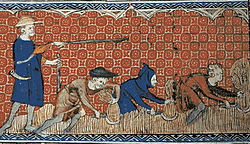Mesne lord
A mesne lord (
In an English
A mesne lord did not hold land directly of the king, that is to say he was not a tenant-in-chief. His subinfeudated estate was called a "mesne estate" or Afterlehen in the Holy Roman Empire. Traditionally, he is a lord of the manor who holds land from a superior lord and who usually lets some of the land to a tenant. He was thus an intermediate or "middle" tenant, which status is reflected in the Old French word mesne, in the modern French language moyen.[6][7]
The mesne lordship of Potter Newton was probably held in 1166 by Herbert de Arches. Mesne lords continued to exist after the abolition of any further subinfeudation by the statute of Quia Emptores (1290). However, with time and the loss of records (except in the case of former copyhold land), it came to be assumed that most land was held directly of the Crown.[8][9][10]
The title of a mesne lord remained a legal entity throughout the 19th century; in 1815, Encyclopaedia Londinensis records that a "Lord mesne is the owner of a manor and by virtue thereof hath tenants holding of him in fee, and by copy of court roll; and yet holds himself of a superior lord called Lord Paramount".[11][12] However, escheat in want of heirs to mesne lords was abolished by the Administration of Estates Act 1925.[13]
See also
References
- ^ "mesne". Oxford English Dictionary third edition. Oxford University Press. September 2001. Retrieved 13 January 2019.
- ^ Pickering, W. (1870). "Archaeologia Cambrensis". W. Pickering, 1870. p. 13. Retrieved 2 May 2018.
The Normans...created sub or mesne manors, corresponding to their new partition of the estates.
- ISBN 9780414045965. Retrieved 1 May 2016.
- ISBN 9781843837121. Retrieved 3 May 2018.
...land was held of tenants-in-chiefs and mesne lords...Also significant was the partition of estates among co-heirs...
- ^ Duke of Beaufort, Henry Charles Fitzroy Somerset (1863). In the Common Pleas His Grace the Duke of Beaufort Against John Crawshay Bailey and Others. Watkins, Hooper, Baylis, and Baker. p. 57.
- ISBN 9781584772620.
- ^ "Mesne lord". Oxford University Press. Retrieved 13 January 2019.
Mesne lord - A lord in the middle of the feudal hierarchy, i.e. a lord of a manor who held land from a superior lord and who let the land to a tenant.
- ^ Megarry, Wade and Harpum (2012), The Law of Real Property (8th Edition), 2-018 (p.29)
- ^ Does feudalism have a role in 21st century land law? (Charles Harpum)
- ISBN 9780861810017. Retrieved 13 January 2019.
Potter Newton. Map 19 shows the whole of Gipton as forming part of the manor of Kippax, but this may be an ... Potter Newton The mesne lordship of Potter Newton was probably held in 1166 by Herbert de Arches, who held two knights' fees....
- ^ Wilkes, J. (1815). "Encyclopaedia Londinensis, Volume 13". J. Wilkes, 1815. p. 661. Retrieved 15 January 2019.
Chapter - LORD:Lord is also a title......Lord mesne is the owner of a manor and by virtue thereof hath tenants holding of him in fee, and by copy of court roll; and yet holds himself of a superior lord called Lord Paramount.
- ^ The Jurist, Volume 10, Part 1. S Sweet, 1865. 1865. pp. 893–895. Retrieved 13 January 2019.
- ^ Administration of Estates Act 1925 s. 45(1)(d)

